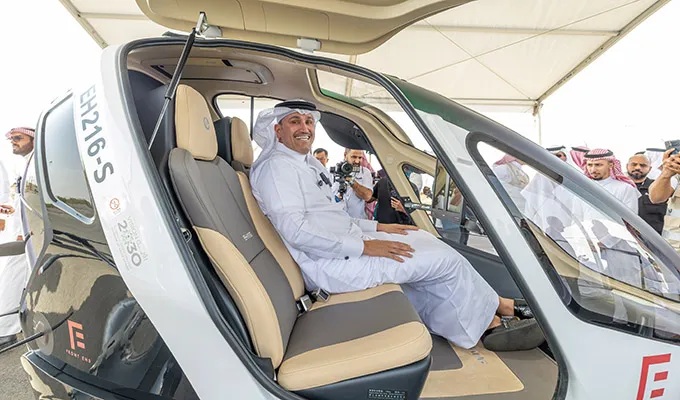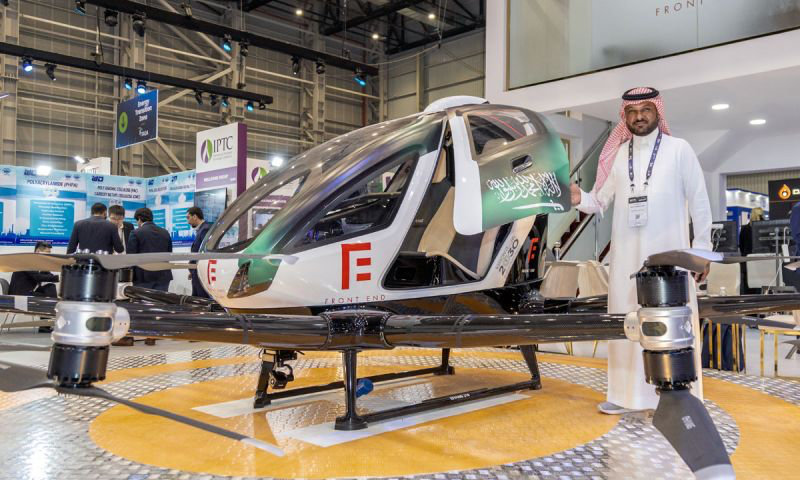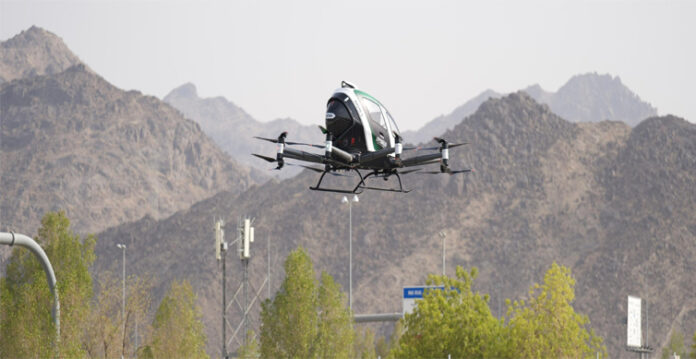The first-ever licensed autonomous air taxi, the EH216-S from EHang Holdings, successfully performed its inaugural flight in Mecca, Saudi Arabia, on June 12, 2024, marking a significant milestone in the transportation industry. As a major step forward in Saudi Arabia’s development of aerial transportation, this pilotless electric vertical takeoff and landing (eVTOL) vehicle carried pilgrims on the Hajj. This essay explores this momentous occasion in depth, as well as how it affects advanced air transportation more broadly and the potential applications of autonomous air taxis in the future.

Saudi Arabia Pioneering Autonomous Air Mobility
EHang’s EH216-S made its inaugural flight at Mecca in cooperation with Front End Limited Company, a Saudi company. This event, which has the support of multiple Saudi government agencies, such as the Ministry of Interior, the Ministry of Hajj, the General Authority of Civil Aviation (GACA), and the Ministry of Transport and Logistics Services, highlights Saudi Arabia’s dedication to incorporating advanced air mobility (AAM) solutions into its transportation network.
“This debut flight of the EH216-S pilotless eVTOL in Saudi Arabia marks a significant milestone in EHang’s ongoing internationalization and an important step forward in propelling global advanced UAV reform,” said Huazhi Hu, founder, CEO, and chairman of EHang, underscoring the importance of this event.
Also Read :- Dubai’s Air Taxis Are About to Transform City Transportation in 2024
Vision for the Advanced Air Mobility
The autonomous flight is in line with Saudi Arabia’s Vision 2030 national goal, which seeks to develop a “Connected Kingdom” and position the kingdom as the Middle East’s center for cutting-edge transportation solutions. A strategy framework known as Vision 2030 aims to diversify Saudi Arabia’s economy, lessen its reliance on oil, and expand the country’s public service industries, which include tourism, infrastructure, health, and education.
In highlighting the significance of the trial, GACA President Abdulaziz Al-Duailej said, “The trial marks a major advancement in integrating Advanced Air Mobility solutions into Saudi Arabia’s aviation landscape.” This experiment lays the groundwork for further advancements in the industry while also showcasing the possibilities of pilotless eVTOL vehicles.
Assistance from Saudi Authorities
Prominent Saudi leaders, including Saudi Arabia’s Minister of Transport and Logistics Services Saleh Al-Jasser, attended the occasion. Their presence is a testament to the government’s strong backing for this cutting-edge transportation project. In order to successfully navigate the regulatory environment and obtain the required permissions for EHang’s eVTOL concept in Saudi Arabia, the partnership with Front End Limited Company was essential.
Technical Details and Novelties
The EH216-S is an autonomous two-seater aircraft with remarkable technical features from EHang. It has a maximum freight capacity of 485 pounds (220 kilograms) and can carry two passengers. It is perfect for urban settings because to its small size, measuring 1.85 meters in height and 5.63 meters in width. It’s especially impressive how quickly the car can charge its batteries—it can go from 30% to 80% in less than ten minutes. The EH216-S can provide dependable and environmentally friendly transportation options because to its efficiency.

Global Protests and Growing Audience
Before being on display in Saudi Arabia, EHang showed off the EH216-S and other models intended for aerial logistics and firefighting at a passenger demonstration in Abu Dhabi. Pilotless eVTOL aircraft deployment in low-risk airspaces requires the establishment of the regulatory framework, which these experiments are crucial for achieving.
Additionally, EHang is reaching farther into the travel industry. With ambitions to offer an additional 450 electric aerial vehicles (EAVs) for aerial tourism and passenger transportation over the next two years, the business recently struck an agreement to sell 50 EAVs to Xishan Tourism. This growth indicates EHang’s dedication to advancing cutting-edge air mobility solutions on a worldwide scale.
Prospects for Autonomous Air Taxis in the Future
Saudi Arabia is investigating how air taxis may be used for a number of purposes, including as carrying medical supplies, easing emergency travel, transferring pilgrims between hallowed sites, and assisting with administrative tasks. “Aligned with Saudi Vision 2030, our goal is to foster a ‘Connected Kingdom,’ serving as a gateway for our partners to access growth opportunities in Saudi Arabia and the wider region,” said Majid Alghaslan, chairman and CEO of Front End, emphasizing the larger vision.
Conclusion
A significant development that highlights the possibilities of cutting-edge air transportation solutions is the debut of EHang’s EH216-S autonomous air taxi in Saudi Arabia. This effort, which has the backing of Saudi authorities and is clearly in line with Vision 2030, opens the door for further transportation-related innovations in the future. A network of interconnected, sustainable, and efficient transportation is becoming a reality as long as EHang keeps showcasing its technology across the world.
Disclaimer: The information provided in this article is based on available sources and may not be 100% accurate.

